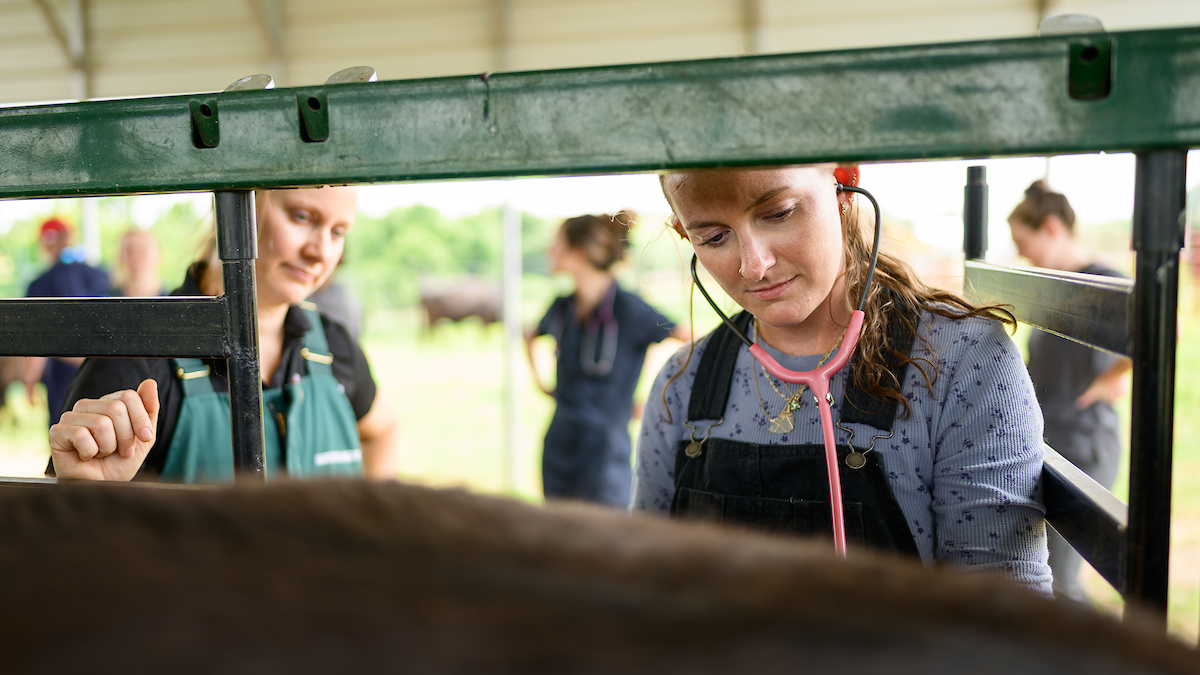Neural Transplant Reduces Absence Epilespsy Seizures in Mice

Stargazer mouse looks upward at transplanted GABAergic neuron (green) in its primary visual cortex. Art by Alice Harvey.
New research from North Carolina State University pinpoints the areas of the cerebral cortex that are affected in mice with absence epilepsy and shows that transplanting embryonic neural cells into these areas can alleviate symptoms of the disease by reducing seizure activity. The work may help identify the areas of the human brain affected in absence epilepsy and lead to new therapies for sufferers.
Absence epilepsy primarily affects children. These seizures differ from “clonic-tonic” seizures in that they don’t cause muscle spasms; rather, patients “zone out” or stare into space for a period of time, with no memory of the episode afterward. Around one-third of patients with absence epilepsy fail to respond to medication, demonstrating the complexity of the disease.
Troy Ghashghaei, an assistant professor of neurobiology in the College of Veterinary Medicine’s Department of Molecular Biomedical Sciences, and his colleagues looked at a genetic mouse model for absence epilepsy to determine what was happening in their brains during these seizures. They found that the seizures were accompanied by hyperactivity in the areas of the brain associated with vision and touch – areas referred to as primary visual and primary somatosensory cortices in the occipital and parietal lobes, respectively.
“There are neurons that excite brain activity, and neurons that inhibit activity,” Ghashghaei says. “The inhibitory neurons work by secreting an inhibitory neurotransmitter called gamma-aminobutyric acid, or GABA. The ‘GABAergic’ interneurons were recently shown by others to be defective in the mice with absence seizures, and we surmised that these malfunctioning neurons might be part of the problem, especially in the visual and somatosensory cortical areas.”
Ghashghaei’s team took embryonic neural stem cells from a part of the developing brain that generates GABAergic interneurons for the cerebral cortex. They harvested these cells from normal mouse embryos and transplanted them into the occipital cortex of the genetic mice with absence seizures. Absence seizure activity in treated animals decreased dramatically, and the mice gained more weight and survived longer than untreated mice.
“This is a profound and remarkably effective first result, and adds to the recent body of evidence that these transplantation treatments can work in mouse models of epilepsy. But we still don’t understand the mechanisms behind what the normal inhibitory cells are doing in areas of the visual cortex of absence epileptic mice,” Ghashghaei says. “We know that you can get positive results even when a small number of transplanted neurons actually integrate into the cortex of affected mice, which is very interesting. But we don’t know how the transplanted cells are connecting with other cells in the cortex and how they alleviate the absence seizures in the mouse model we employed.
“Our next steps will be to explore these questions. In addition, we are very interested in methods being devised by multiple labs around the world to ‘reprogram’ cells from transplantation patients to generate normal GABAergic and other types of neurons. Once established, this would eliminate the need for embryonic stem cells for this type of treatment. The ultimate goal is to develop new therapies for humans suffering from various forms of epilepsies, especially those for whom drugs do not work.”
The research appears online in Cerebral Cortex. The research was partly funded by the National Institutes of Health. Ghashghaei is leader of the Center for Comparative Medicine and Translational Research’s comparative neurobiology core in the College of Veterinary Medicine. Co-authors include post-doctoral fellow Mohamed Hammad (now at the University of Southern California), research associate Xuying Zhang, and veterinary student Ryan Bray who began this work through the Veterinary Scholars Program. Stephen Schmidt and Flavio Frohlich, electrophysiologists at the University of North Carolina at Chapel Hill, made important contributions to the work.
-peake-
Note to editors: Abstract follows.
“Transplantation of GABAergic Interneurons into the Neonatal Primary Visual Cortex Reduces Absence Seizures in Stargazer Mice”
doi:10.1093/cercor/bhu094
Authors: Mohamed Hammad, Xuying Zhang, Ryan Bray, and H. Troy Ghashghaei, North Carolina State University; Stephen L. Schmidt, and Flavio Frohlich, UNC Chapel Hill
Published: Online in Cerebral Cortex
[section_subtitle] Abstract: [/section_subtitle]
Epilepsies are debilitating neurological disorders characterized by repeated episodes of pathological seizure activity. Absence epilepsy (AE) is a poorly understood type of seizure with an estimated 30% of affected patients failing to respond to antiepileptic drugs. Thus, novel therapies are needed for the treatment of AE. A promising cellbased therapeutic strategy is centered on transplantation of embryonic neural stem cells from the medial ganglionic eminence (MGE), which give rise to gamma-aminobutyric acidergic (GABAergic) interneurons during embyronic development. Here, we used the Stargazer (Stg) mouse model of AE to map affected loci using c-Fos immunohistochemistry, which revealed intense seizure-induce activity in visual and somatosensory cortices. We report that transplantation of MGE cells into the primary visual cortex (V1) of Stg mice significantly reduces AE episodes and lowers mortality. Electrophysiological analysis in acute cortical slices of visual cortex demonstrated that Stg V1 neurons exhibit more pronounced increases in activity in response to a potassium-mediated excitability challenge than wildtypes (WT). The defective network activity in V1 was significantly altered following WT MGE transplantation, associating it with behavioral rescue of seizures in Stgs. Taken together, these findings present MGE grafting in the V1 as a possible clinical approach in the treatment of AE.


